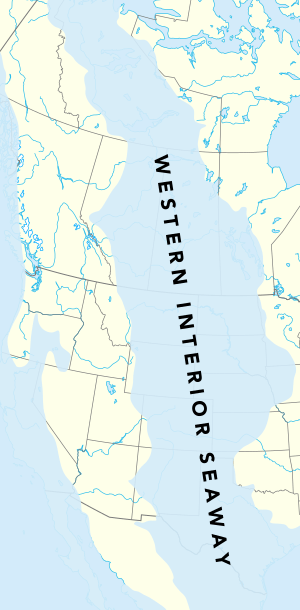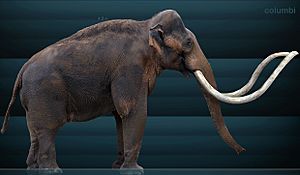Paleontology in Nebraska facts for kids

Paleontology in Nebraska is all about finding and studying fossils in the state of Nebraska. Nebraska is super famous for its amazing fossil discoveries!
Millions of years ago, during the early Paleozoic time, Nebraska was covered by a shallow sea. This sea was probably home to creatures like brachiopods (shellfish), corals, and trilobites (ancient sea bugs). Later, during the Carboniferous time, huge swamps and river deltas spread across the state.
The Permian period saw Nebraska mostly as dry land. We don't have many rocks from the Triassic and Jurassic periods in Nebraska. But during the Cretaceous period, a giant inland sea called the Western Interior Seaway covered the state. Ammonites (shelled squid-like animals), fish, sea turtles, and huge plesiosaurs (long-necked marine reptiles) swam in this sea. The land along the coast had early flowers and dinosaurs!
When the sea dried up in the early Cenozoic era, Nebraska became home to large mammals like camels and rhinoceros. During the Ice Age, glaciers covered parts of Nebraska. Giant animals like the huge bear Arctodus, horses, mammoths, mastodons, and Saber-toothed cats roamed the land.
Long ago, Native Americans in the area had their own stories about fossils. They sometimes thought fossils were from water monsters killed by powerful thunderbirds. Later, scientists began studying these fossils. They made big discoveries, like the amazing mammal bone beds at Agate Springs. The Pleistocene mammoths Mammuthus primigenius, Mammuthus columbi, and Mammuthus imperator are even the official Nebraska state fossils!
Contents
Nebraska's Ancient Past
Nebraska's fossil story begins in the Paleozoic era. From the Cambrian to the Devonian periods, a shallow sea covered Nebraska. We don't see many rocks from this time on the surface. But fossils from nearby states suggest Nebraska had brachiopods, corals, and trilobites.
During the Carboniferous period, the sea moved west. Big swamps in river deltas took its place. In these swamps, you could find sea creatures like cephalopods (like squid), coral, crinoids (sea lilies), and tiny fusulinids. Plants also left their fossils behind. By the Permian period, most of Nebraska was dry land. But there were still some lakes and rivers. These waters were home to aquatic plants, amphibians, and fish.
Dinosaurs and Sea Monsters
From the Triassic to Jurassic times, Nebraska's land was mostly eroding, not collecting new sediments. But in the Cretaceous period, the Dakota Formation in eastern Nebraska preserved dinosaur fossils. Later in the Cretaceous, Nebraska was covered by the Western Interior Seaway.
This huge sea was filled with life! Ammonites, fish, sea turtles, and plesiosaurs swam here. Some plesiosaurs could grow up to forty feet long! The sharks in Nebraska during the Cretaceous were very similar to those found in Kansas. On land, flowering plants became common. The coastal plains were home to dinosaurs.
Mammals Take Over
The Western Interior Seaway was gone from Nebraska by the early Cenozoic era. The land became a mix of lakes and rivers. The animals living then were similar to modern ones. Sometimes, volcanic activity from the Rocky Mountains covered parts of Nebraska in ash.
Rhinoceroses first appeared in Nebraska during the Eocene epoch. They lived on the plains for about 35 million years! In fact, more rhino fossils from this time have been found in Nebraska than any other state.
Rhinos were a big part of Nebraska's animal life during the Oligocene epoch. Camels also arrived, with Poebrotherium being the earliest known type. At Scotts Bluff National Monument, you can find fossilized footprints from Oligocene animals. These are rare, being one of only seven such sites in the western United States.
During the Miocene epoch, Nebraska was likely home to huge herds of the small rhino Diceratherium cooki. This rhino made up about a quarter of the fossils found at the famous Agate Springs beds. Other Agate Springs fossils included bears, the pig-like Dinohyus, horses, the unique Moropus (a type of perissodactyl or odd-toed mammal), and tapirs. Later in the Miocene, the rhino Teleoceras lived here.
In the middle Pliocene epoch, Aphelops and Diceratherium lived in Nebraska. About 70% of Nebraska's large mammals disappeared during a big extinction event late in the Pliocene.
Ice Age Giants
During the Pleistocene epoch, glaciers left behind sediments that preserved many local animals. Early in this Ice Age, Nebraska had Giganticamelus fricki, a giant camel over eleven feet tall!
Large mammals thrived in Nebraska during the Ice Age. These included the giant bear Arctodus, horses, jaguars, mammoths, mastodons, shovel-tusked proboscideans (like elephants), saber-toothed cats, and tapirs. The biggest Arctodus fossils in Nebraska came from Sheridan and Cass Counties. Fossils of mastodons and mammoths have been found in all 93 counties of Nebraska! Woolly mammoth remains were most common in western Nebraska, in areas like Dawes and Sioux Counties.
After the Kansan glaciation (a period of ice), Nebraska was home to bears, giant bears, giant bison, caribou, wild cats, wild cattle, cougars, deer, jaguars, true moose, animals like musk oxen, actual musk oxen, mountain sheep, and giant stag-moose. Archidiskodon imperator maibeni left fossils in Lincoln County. Platycerabos dodsoni was a wild cow found in Cass County. Other late Pleistocene mammals included Amebelodon fricki (another shovel-tusked proboscidean), extinct bison species, modern bison, modern coyotes, and a different type of saber-toothed cat (not Smilodon). The camel Camelops appeared later in the Pleistocene. Some fossil sites from this time even show animal remains found with signs of humans.
Discovering Fossils
Early Scientific Research
The mammal fossils from the Tertiary in Nebraska have been very important for American paleontologists. In 1867, a government survey led by Ferdinand Vandeveer Hayden found mammoth and mastodon fossils in Sheridan County.
Ten years later, in 1877, a scout and rancher named Captain James H. Cook made a huge discovery. He found a Miocene bone bed in Sioux County. This site is now known as the Agate Springs Quarries or Agate Bone Beds. These rich deposits are packed with bones! One forty-foot slab of sandstone had over 4,300 bones from at least 1,700 different animals. The total number of fossils here might be in the millions. The small rhinoceros Diceratherium cooki made up about a quarter of the remains at Agate Springs. This was the first fossil discovery that really got the public interested in Nebraska's fossils.
In 1891, the University of Nebraska began its fossil fieldwork in western Nebraska.
Just a few miles from Agate Springs, F. B. Loomis made another big find. In 1907, he discovered a fossil camel. Only a year later, five major museums and universities sent teams to the area. That year, they uncovered 21 ancient camel skeletons. The next year, the American Museum of Natural History found nine more camel skeletons at Loomis's site. Most of the skeletons found were "articulated," meaning the bones were still connected as they would be in a living animal. It's not clear how so many camels ended up in one place. One idea is that they were all victims of a single disaster.
During the building of the Medicine Creek Dam in Frontier County, the University of Nebraska and other groups worked together. They studied fossils and archaeological sites in seven different locations before the dam's reservoir covered them. By 1949, the dam was finished, and these fossil sites were submerged.
In 1961, the University of Nebraska opened the Trailside Museum of Natural History at Fort Robinson State Park. This museum, which used to be a theater, now holds many fossils. Its creation was a very important step for paleontology in Nebraska. Two years later, in 1963, the University of Nebraska reopened its Mastodon Quarry at Red Cloud in southern Nebraska. Important finds were made there. One was a nearly complete skeleton of a mastodon relative that had four tusks! This skeleton was put together and displayed in a museum.
On May 24, 1965, the Agate Fossil Beds became a national monument. The land was owned by Harold J. Cook, the son of James H. Cook who first found the fossils. Harold Cook generously donated the land for the monument.
Places to Visit
Natural History Museums
- Hastings Museum of Natural and Cultural History, Hastings, Nebraska
- Trailside Museum of Natural History at Fort Robinson State Park, Crawford, Nebraska
- University of Nebraska State Museum, Lincoln, Nebraska



